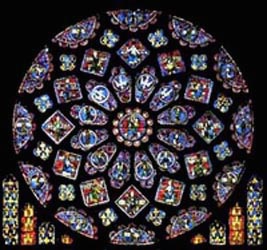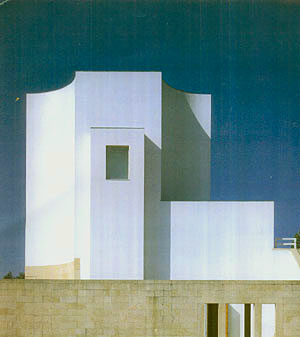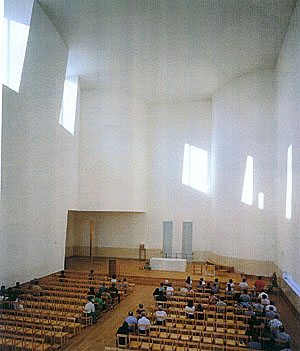 |
Art & Architecture
Clash of Gothic and Cartesian Mentalities
Lyle J. Arnold, Jr.
"The common root of the different aspects of medieval culture lays in the personality of Jesus"(1).
As this personality approached its apex in the 13th century, Gothic architecture and art were the perfect complements to the medieval spirit. Castles, churches, abbeys, universities, civic buildings, all expressed the marvel of the Gothic mentality.

A gothic jewel in Chartres, France |
Cathedrals are often the best example, with the façade expressing the might of God and His Holy Church. The spires and towers on the exterior of the buildings demonstrate height, reaching out as it were, to Heaven. On the interior the attached shafts can be seen sweeping "unbroken from the floor to the ceiling" where they meet with "the ribs of the vault, like a tree spreading into branches” (2). The arched windows of stained glass add colored and joyful light, providing an art both figurative and narrative.
The ensemble is appealing to both body and soul. The spiritual genius of the Gothic is the antithesis of the modern Cartesian mentality. An example of the former can be seen in the rose window of Chartres Cathedral, at left.
Santa Maria Church in the city Marco de Canavezes, Portugal (3) was designed by Alvaro Siza. It displays no Christian symbols whatsoever, neither on the exterior nor the interior. It is a blank. The outside could be anything from a lunatic asylum to a Masonic building in any city, or any building, be it a bank or a hospital that kills babies.

The hard cold Cartesian lines of Santa Maria Church, a modern monstrousity in Portugal
 |
Inside the church, a white box – the altar - rests atop an elevated platform, where the nave blends into the void of the ensemble. There is no monarchial point or chancel. Taken as a whole, one could be inside a sterile operating room, or a modern kitchen, or an execution chamber. A person sitting in the pew sees only an abyss of light, barren, cobalt-like. (4) Nietzsche (who went insane at age 44) once said "And if thou gaze long into the abyss, the abyss will also gaze into thee." (5)
Inside Santa Maria Church there is existential aloneness, the negation of Nietzsche. It is the abyss of non-being. Since Vatican II, churches have been notoriously deconstructed of beauty and mystery. Not all of them, however, have reached the bleached barrenness that is represented by Santa Maria. This does not mean they will not.
In commenting on the pace of the Revolution, Prof. Plinio Corrêa de Oliveira made an important observation on a revolutionary that moves slowly vis-à-vis a fast one. The faster-paced revolutionary "raises up a standard and creates a fixed target that fascinates the moderates by its very radicalism. Accordingly, they slowly advance toward it." (6)
In the vortex of Progressivism (as in the Santa Maria Church) that exists today, we see a personality at enmity with that of Our Lord. Almost all Catholics have been moving willy-nilly towards the vacuum of existentialist goals. The standard raised by Progressivism seems to fascinate all but the counter-revolutionary remnant.
What comes next after Santa Maria Church? Once the abyss is reached, and it gazes into the soul, moral and clinical insanity must await. Then destruction and hell.
May our prayers go out to those who have given themselves to Progressivism, that Our Lady of Fatima's promise of Her Immaculate Heart's triumph will reach them before it is too late.
1. Paul Frankl. A History of Western Architecture, NY: David Watkin, Thames and Hudson, 1986, p. 126.
2. “Gothic architecture,” Wikipedia.
3. Judith Dupre, Churches, HarperCollins/Pub/NY, 2001, pp. 150-151.
4. Cobalite is a silver-white mineral. Interestingly, the root word of cobalt is "goblin." The term came to be used by miners, who believed that goblins substituted it for silver.
5. Beyond Good and Evil.
6 Plinio Correa de Oliveira, Revolution and Counter-Revolution, New Rochelle, NY: The Foundation for a Christian Civilization, 1980.

Posted July 5, 2007

Related Topics of Interest
 St. Peter & the Vatican Exhibit: Marvelous Continuity, Shocking Change St. Peter & the Vatican Exhibit: Marvelous Continuity, Shocking Change
 Eric Gill: A Precursor of Vatican II Eric Gill: A Precursor of Vatican II
 The Taste for the Macabre in Today's Art The Taste for the Macabre in Today's Art
 The Scandalous New Look of Christ The Scandalous New Look of Christ
 Revolution and Counter-Revolution in the Tendencies, Ideas, and Facts Revolution and Counter-Revolution in the Tendencies, Ideas, and Facts

|
Art & Architecture | Hot Topics | Home | Books |
CDs | Search | Contact Us | Donate

© 2002-
Tradition in Action, Inc. All Rights Reserved
|
 |
|